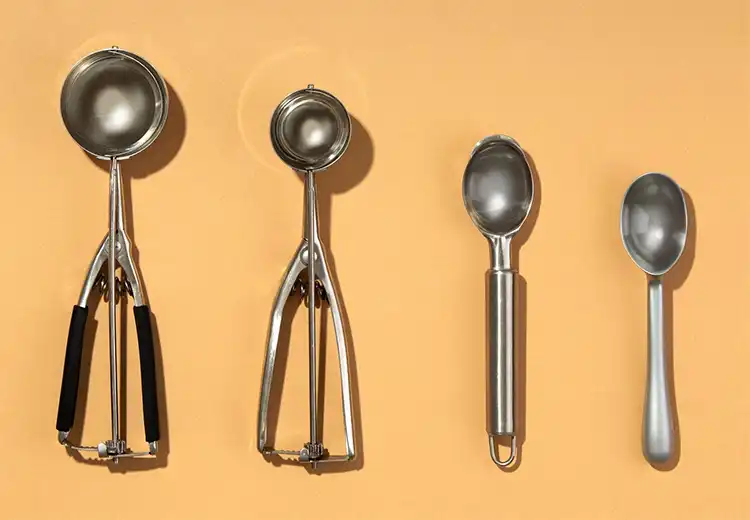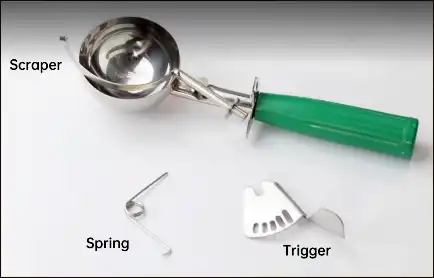Is your kitchen scoop hard to clean? Food gets stuck in tiny spaces. Many don’t know how to clean a kitchen scoop with narrow crevices. This leads to germs and bad smells. Our easy tips will help you make your scoop look new again. Keep reading to learn how!
A kitchen scoop helps portion cookie dough, grains, or pet food. Crumbs and sticky residue hide in narrow crevices. With simple tools and our step-by-step guide, you can clean even the tiniest nooks. Let’s get your kitchen scoop working like new again.

Table of Contents
Why Narrow Crevices Are a Cleaning Challenge?
Kitchen scoops often have hinges, springs, or seams that trap:
- Sticky residues (dough, honey, oils).
- Dry debris (flour, spices, pet food crumbs).
- Hardened gunk from infrequent cleaning.
Ignoring these areas can lead to mold, unpleasant smells, or mechanical failure. Let’s tackle them!
Tools You’ll Need
- Dish soap or baking soda
- Warm water
- Soft-bristle toothbrush or detailing brush
- Pipe cleaners or dental floss
- Cotton swabs
- White vinegar (for disinfecting)
- Toothpicks or wooden skewers
- Microfiber cloth

Step-by-step: How to Clean a Kitchen Scoop with Narrow Crevices?
The methods for cleaning a kitchen scoop with a narrow crevice are described in sequence below.
Step 1: Disassemble the Scoop (If Possible)

- Check if your scoop has removable parts (e.g., springs, levers).
- Unscrew or detach components carefully (refer to the manufacturer’s guide).
- Soak detachable parts in warm, soapy water to loosen debris.
⚠️ Avoid harsh chemicals if your scoop has plastic or silicone parts.
Step 2: Soak the Scoop
- Fill a bowl with hot water and dish soap (or 1 cup vinegar + 2 cups water for disinfecting).
- Submerge the scoop for 15–20 minutes to soften residue.
Step 3: Scrub Crevices with Targeted Tools
Use a toothbrush or detailing brush:
- Dip the brush in soapy water.
- Scrub back and forth along seams, hinges, and tight corners.
Floss stubborn gaps:
- Thread dental floss or a pipe cleaner through crevices to dislodge stuck particles.
Pick out debris:
- Gently scrape residue with a toothpick or skewer (avoid scratching surfaces).
Step 4: Deep Clean with Baking Soda Paste
For sticky or greasy buildup:
- Mix 1 tbsp baking soda + 1 tsp water to form a paste.
- Apply the paste to crevices with a cotton swab.
- Let sit for 5 minutes, then scrub with a brush.
- Rinse thoroughly.
Step 5: Disinfect and Deodorize
- Soak the scoop in a 1:1 vinegar-water solution for 10 minutes to kill bacteria.
- For lingering odors, sprinkle baking soda inside crevices, let sit overnight, then rinse.
Step 6: Dry Thoroughly
- Shake off excess water.
- Use a microfiber cloth to pat dry.
- Let air-dry completely in a well-ventilated area to prevent mold or rust.
Preventive Maintenance Tips
- Rinse immediately after use to avoid residue hardening.
- Avoid dishwashers for scoops with springs or narrow parts (hand-wash instead).
- Lubricate hinges with food-safe mineral oil monthly.
- Store in a dry place away from humidity.
When to Replace Your Kitchen Scoop?
If cleaning doesn’t resolve these issues, it’s time for a new scoop:
- Cracks or warping in plastic parts.
- Persistent mold in unreachable crevices.
- Rusted springs that won’t function smoothly.
👉 Pro Tip: Opt for scoops with smooth, one-piece designs or dishwasher-safe materials (like stainless steel) to minimize crevice buildup.
Final Thoughts
Learning how to clean a kitchen scoop with narrow crevices is easier than you think! First, use a soft brush to loosen crumbs. For tight spots, slide dental floss or a pipe cleaner through crevices. Mix baking soda and water into a paste to dissolve sticky residue—scrub gently, rinse, and dry.
Always rinse the scoop right after use to avoid buildup. Keep it dry for long-lasting freshness. Quick, effective, and stress-free!
Pro tip: A clean scoop works best with the right tools! Check out our picks for the best cookie scoop for thick dough to bake like a pro.
Related Articles:
- The Ultimate Guide to Essential Kitchen Tools of 2025
- Kitchen Utensils and Their Uses: 2 Different Essential Types
- 10 Kitchen Utensils And Their Uses | Every Cook Must Know
FAQ: Cleaning Narrow Crevices
Can I use a toothbrush to clean my kitchen scoop?
Yes! A soft-bristle toothbrush is perfect for scrubbing tight spaces.
How do I clean a scoop with a spring inside?
Soak it in soapy water, then work the spring back and forth while submerged to flush out debris.
Is bleach safe for cleaning kitchen scoops?
Avoid bleach on porous materials like plastic. Use vinegar or baking soda for safe disinfecting.
Why does my scoop still smell after cleaning?
Odors may linger in microscopic cracks. Soak in vinegar or baking soda overnight.






